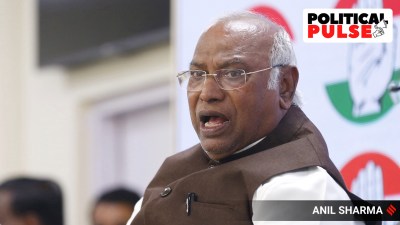- India
- International
Soft power can be effective
In countering China, India should go back to it strength of reaching out to people of other civilisations, emphasising cultural affinities with them
 Prime Minister Narendra Modi in Leh. The recent Galwan military standoff has complicated our ties with China, deepened suspicions and misgivings. (File/PTI Photo)
Prime Minister Narendra Modi in Leh. The recent Galwan military standoff has complicated our ties with China, deepened suspicions and misgivings. (File/PTI Photo)
Prime Minister Narendra Modi recently sent a subtle message to China from Nimmu that ‘the era of expansionism is over’. Nimmu is located along the Yargal-thang plain where the Mughal-Ladakh army fought a fierce war (the battle of Basgo) in 1679 against the expansionist Qing Empire led by Mongol-Tibetan troops. Together, they gave a bloody nose to the Mongol-Tibetan army and pushed them back beyond Demchok and Pangong Tso to Tashigang.
The Chinese threat to Ladakh has once again become ominous. The Chinese Communist Party’s (CCP) is asserting itself on the lines of the “Sino-centric” idea of the “middle kingdom”.
Beijing seems still operating on its “Li” concept that functioned on a ritualistic tributary system of the “core” dominating the “peripheries” through myriad forms of relationships. After imposing itself on Xinjiang, Tibet and Inner Mongolia, Beijing thinks Ladakh too falls within the pale of Chinese glacis – hence, adding it on the list of territory to be grabbed through a slower build-up game.
China is strangely behaving exactly the way previous classical empires like the Greeks, Romans, Persians, British, French and Russians behaved. They had sought territorial expansion, established colonies, and vassal and buffers states.
The British Empire created “inner and outer” territory and “buffers zones” to mitigate a potential direct threat and to protect its mercantile interests. The Russian Empire opened out to capture Eastern European, Central Asian and Far Eastern spaces simply for the glory of the Czar.

More recently, the Soviet Union and the United States sought ideological goals for global domination. The Soviets created a “sphere of influence” around friendly socialist states to serve as buffers against the West and China. Mikhail Gorbachev eventually had to give them up because of the economic load. But Vladimir Putin is still trying to protect Russia’s “near-abroad” while retrieving its hold over Crimea.
The Ukraine conflict is all about Russia securing a buffer against the West and to protect its energy market in Europe. The Americans continue to their global outreach through friends and allies.
But, China’s never-ending penchant for grabbing land along the “Middle Kingdom” with modern tools is frightening. Unlike previous empires that suffered diminishing returns, China, unfortunately, has the resources and ability to expand further and the willingness to support its faltering clients such as North Korea and Pakistan.
Beijing is using North Korea as an ideological (communist) buffer against South Korea, Japan and the US. In South Asia, it tries to neutralise India’s traditional friends to make them its own friendly buffers against New Delhi. There may be many such sinister designs, but the most manipulative expansionist policy that Beijing pursues is to seek its reunification agenda with Taiwan but tacitly discourage any serious inter-Korean and India-Pakistan rapprochement.
India’s trodden path to its historical greatness had its roots in the practice of its “Rajamandala” idiom – a circle of sacred and friendly space or an Indic world order which was metaphysically embedded in unity through peace. Unlike China’s tributaries federation, the Indian model revolved around the core (centre) rather than on the periphery (boundary). Even “China-des” formed a component of the Indian political and spiritual disposition, at least until the reign of King Harsha.
We have failed to bring in Mount Kailash in our strategic thought process. Only the opening of the Himalayan gateways can help us regain our soft cultural frontiers/buffers.
India should never compare its outreach with the Chinese-style sphere of influence that works on competitive and aggressive behaviour along with other supportive value chain activities. Instead, India should prudently employ its own historical strength and links with adjacent peoples and the land.
More often than not, the law of attraction in India’s case always worked in a reverse way. Instead of chasing others, people, societies and nations across the world always found their own ways to connect with India.
As China opts for expansionism, India should aptly redeploy its long-cherished realist wisdom and adaptability strategy — the hallmark of its diplomacy.
In 2015, Prime Minister Narendra Modi was seen sifting through these ancient tracks to achieve his foreign policy goals. He has since been on a drive to deal even with China in a nonconventional way but in vain.
The recent Galwan military standoff has complicated our ties with China, deepened suspicions and misgivings.
Clearly, the old mechanisms are unlikely to work. The improved commercial ties have failed to build trust. The dispute-handling model has created more friction and fuelled domestic outrage.
A path forward to deal with China demands returning to the strategic fundamentals. Possibly, the solution lies more in culture than in politics or the military. After all, China and India are not ancient enemies.
The challenge for India is also to reach out to the over 600 million estimated Chinese followers of Dharma – India is the land of Buddha Amitabha. This could spring many surprises, just as in Europe before — perhaps even lead to the eventual demise of the CCP.
Reframing the relationship with China needs to be grounded on the shared historical and cultural awareness of each other, as also on the collective wisdom of ordinary citizens on both sides. This may prove to be an effective, evolutionary way. Only then can a harmonious balance with China can be restored.
A new mode of diplomacy should embed in it a samvad, like a “cultural middle”, that can avoid conflicts and work out conciliation, while at the same time uphold India’s integrity. But this would require New Delhi to do away with its usual narrow tactical pursuits that are often devoid of any strategic goals.
The writer, a former ambassador, is an expert on the Himalayan affairs
EXPRESS OPINION
More Explained
Apr 19: Latest News
- 01
- 02
- 03
- 04
- 05









































